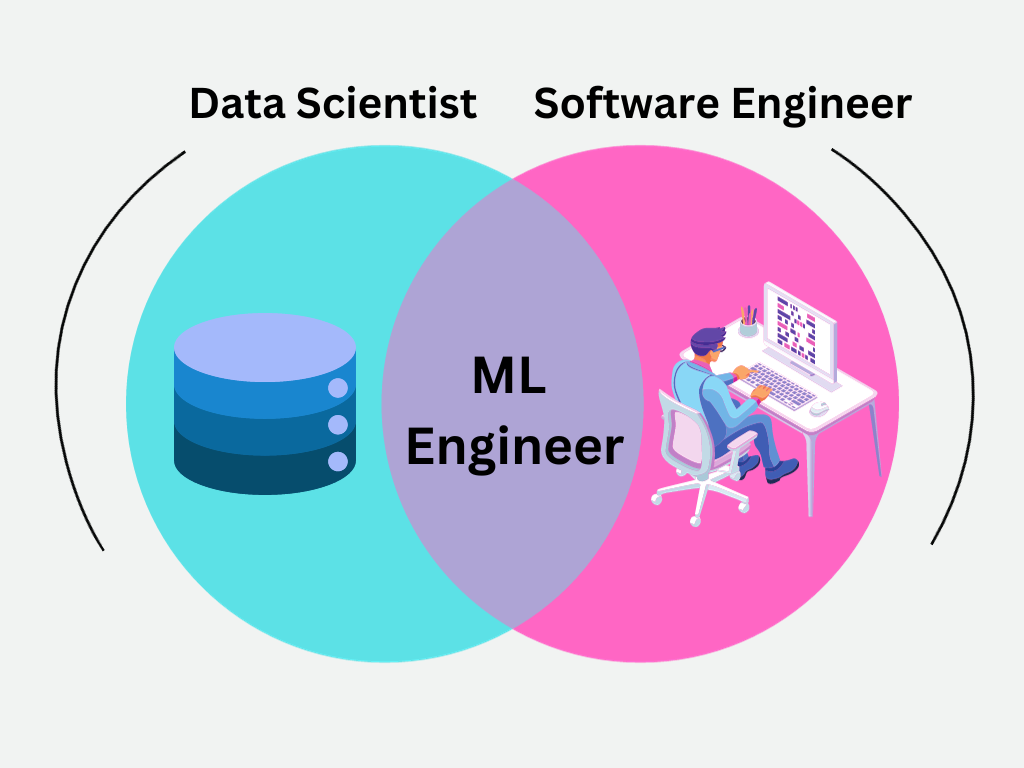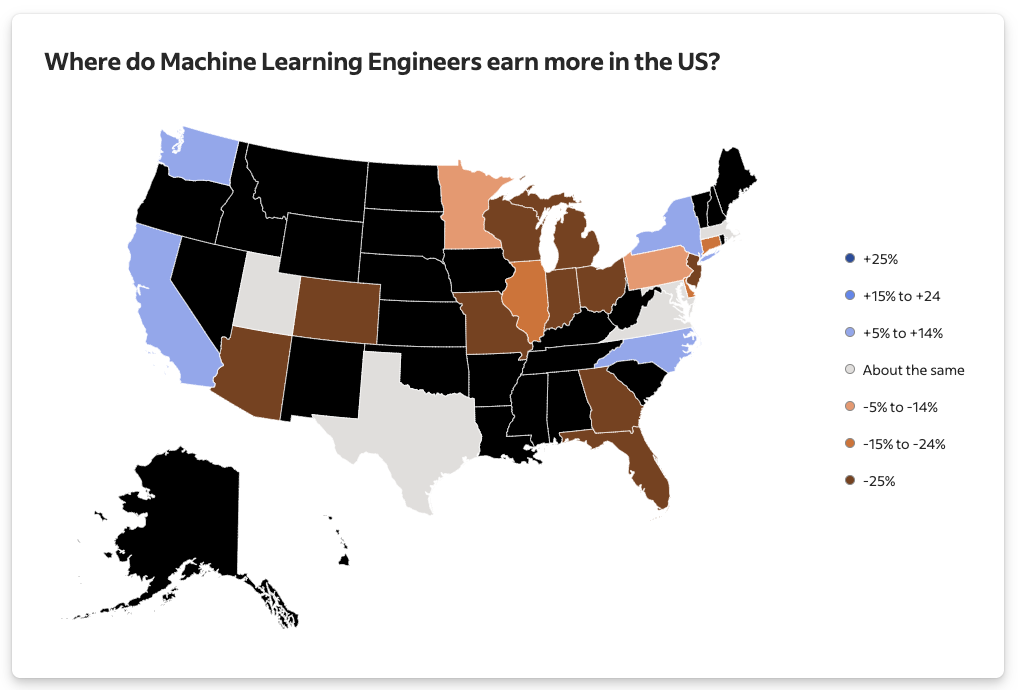Course
In a world where understanding and applying data is more important than ever before, machine learning engineers have emerged as architects of the future, bridging gaps between theoretical models and practical applications. As the demand for this hybrid role surges, understanding the scope, responsibilities, and earning potential becomes essential for both aspiring practitioners and employers.
In this comprehensive guide, we delve into the world of machine learning engineers, exploring their roles, the skills required to become one, and the machine learning engineer salaries on offer in 2026.
We will examine the salaries of machine learning engineers worldwide, breaking them down by region, industry, and seniority. We will also compare them to those of other data-centric roles, such as data scientists and engineers.
You can find out about data scientist salaries and data analyst salaries worldwide in separate articles.
Who Are Machine Learning Engineers?
A decade ago, Harvard Business Review spotlighted data science as the sexiest job of the 21st century. This sparked a revolution in the data industry and birthed specialized roles like the machine learning engineer—a hybrid of a data scientist and a software engineer.
This role emerged when organizations noticed a skill gap in data scientists' ability to deploy machine learning models into real-world applications due to a lack of software engineering expertise. Conversely, conventional software engineers, while adept at building scalable software, struggled with the complexity of machine learning models.
Machine learning engineers, armed with both computer science and machine learning expertise, bridge this gap, ensuring the theoretical soundness of models and their practical implementation.
Here is a Venn diagram showcasing the role of a machine learning engineer:

In the dynamic data landscape, role definitions are often fluid and can vary significantly between organizations, leading to ambiguity in responsibilities and expectations.
The machine learning engineer role, recognized as a bridge between data science and software engineering, is no exception.
It may lean more toward data science in some companies and more toward software engineering in others, reflecting the diverse requirements of different organizations.
Despite this variability, the core expectation remains consistent: these professionals should proficiently implement and integrate machine learning models into scalable, real-world applications.
Roles and Responsibilities of ML Engineers
As explained previously, the exact duties of machine learning engineers can differ based on the organization and sector they work in. However, a review of several job postings reveals the following generally accepted set of responsibilities for this role:
- Designing and developing machine learning systems
- Conducting in-depth statistical analysis
- Running machine learning experiments to evaluate and fine-tune model performance
- Implementing tools to monitor, version, and deploy models effectively
- Enhancing the computational efficiency of machine learning algorithms
- Collaborating with different departments to integrate machine learning models into applications
What Skills Do You Need To Become an ML Engineer?
Here, we’ve outlined some of the basics of the technical and soft skills you’ll need to become a machine learning engineer.
1. ML engineer technical skills
- Programming. Proficiency in at least one programming language, such as Python, Java, or C++, is essential. The focus is on object-oriented programming (OOP) principles. For a deeper understanding of OOP, consider our Object-Oriented Programming in Python course.
- Deep learning frameworks. Knowledge of frameworks like Keras, TensorFlow, and Pytorch is crucial.
- Big data technologies. Familiarity with platforms like Hadoop, Hive, and Spark is beneficial for handling large datasets.
- Model deployment and integration. The ability to deploy algorithms into applications using tools like Flask, Docker, and cloud platforms such as AWS and Google Cloud is necessary.
- Machine learning. A solid grasp of machine learning algorithms and statistical knowledge is required for model fine-tuning and interpretation.
2. ML engineer soft skills
- Collaboration. Effective teamwork and communication are vital for working closely with data science and business professionals.
- Domain-specific knowledge. Understanding the intricacies of your industry is crucial for developing applications aligned with user preferences and industry requirements.
If you'd like to learn more, we have a complete guide on becoming a machine learning engineer that details the various skills, experiences, and steps you need to progress your career.
Machine Learning Engineer Salaries in 2026
Let’s start by exploring how much machine learning engineers get paid across various countries.
Remember that salaries will differ significantly based on the role, industry, and nature of the organization you are working at and that regional variations within a country can also introduce disparities.
That said, we have done our best to represent these salaries accurately and have referenced our sources for all the figures presented.
Here is a salary breakdown of the machine learning engineer role by country:
|
Country |
Average machine learning engineer's annual salary |
Average national annual salary |
|
United States |
||
|
United Kingdom |
||
|
India |
||
|
Canada |
||
|
Australia |
||
|
Singapore |
Let’s explore these numbers in greater detail:
Machine Learning Engineer Salaries in the United States
As of 2026, the average base salary of a machine learning engineer is $183,324. This figure is striking, as it is more than double the national average of $69,846. It is also higher than the average annual salary for data scientists, which is $129,108.
In California, known for its tech-heavy Silicon Valley, machine learning engineers are paid $171,872, which surpasses the national average for the role by 6%. This number increases to $175,132 in Washington, while it is at $152,612 in Texas.

Machine learning engineer salaries in the US - Source
Machine Learning Engineer Salaries in the United Kingdom
In the UK, machine learning engineers are paid an impressive average salary of £57,830 annually. Again, this figure notably surpasses the average earnings of data scientists, who earn around £51,080 a year.
Among cities, London has the highest average salary, where machine learning engineers earn around £67,201 annually. In comparison, this number drops to £56,012 in Edinburgh, while Cambridge trails closely behind London, with a base pay of £68,222.
Machine Learning Engineer Salaries in India
Machine learning engineers in India are paid an average of ₹10,88,060 annually. Surprisingly, in contrast to trends in the US and the UK, this is lower than the compensation of a data scientist, which is approximately ₹11,28,869.
According to Indeed, leading companies like Accenture, Tiger Analytics, and Quantiphi are among the top employers for machine learning engineers in the country. These organizations offer significantly higher salaries than the profession’s average, ranging from ₹11,00,000 and ₹15,00,000 annually.
Machine Learning Engineer Salaries in Canada
The average annual compensation of a machine learning engineer in Canada is $116,235. Toronto tops the list as the highest-paying city, with a base salary of $119,253, which is approximately 21% higher than the national average.
Machine Learning Engineer Salaries in Australia
In Australia, machine learning engineers boast an average salary of $151,132 annually. This is around 50% above the national average of around $98,000. It is also significantly higher than the compensation provided in other technical roles, such as data science, software engineering, and machine learning engineering.
Breaking this down by state, machine learning engineers in Sydney are very well compensated, commanding an average of $185,213 - 12% more than the national average. In comparison, these professionals receive approximately $116,887 in Melbourne, while the salaries in Brisbane drop to about $117,319.
Machine Learning Engineer Salaries in Singapore
The average salary of a machine learning engineer in Singapore is approximately $129,929. This is far higher than the national average of $70,000. The top employers for this profession include tech and financial giants such as Google, TikTok, and Standard Chartered Bank.
These leading organizations offer enticing salary packages that are far higher than the country’s average for this profession, ranging from $160,000 to $210,000 per year.
Machine Learning Engineer Salaries at FAANG Companies
Machine learning engineers in “Big Tech” earn far higher salaries than the average market rate. These organizations are also known as the Tech Giants and refer to the five most prominent technology companies—Facebook, Amazon, Apple, Netflix, and Google, also known as “FAANG.”
Here is a list of machine learning engineer salaries at these firms.
Machine Learning Engineer Salaries at Meta
According to Glassdoor, the average base pay of machine learning engineers at Meta is $122,619 annually. With bonuses and additional commissions, this number rises to a total estimated salary of $151,989 annually.
Facebook also offers its employees flexible work arrangements and provides benefits such as wellness reimbursements and mental health benefits, making it an ideal place to work.
Machine Learning Engineer Salaries at Amazon
Machine learning engineers at Amazon are paid even more than those at Facebook. The average base pay at this company is approximately $155,000 annually, and it increases to around $235,000, including bonuses, stocks, and additional commissions.
The company also offers its employees a wide range of benefits, such as free access to a network of caregivers if they have dependents, financial counseling, and estate planning services.
Machine Learning Engineer Salaries at Apple
Apple pays machine learning engineers a base salary of around $193,000, which is higher than the salaries at Facebook and Amazon. This number increases to a total of $300,000 once you include benefits like bonuses. The company also has a hybrid work model, providing employees better flexibility.
Additional employee benefits at Apple include discounts on Apple products, free online courses for upskilling, tuition fee reimbursement if you’d like to pursue higher education, and free dinner five days a week.
Machine Learning Engineer Salaries at Netflix
Netflix's machine learning engineers are paid a base salary of $186,000 annually, which is on the higher end of the scale even among other FAANG companies. In addition to this base income, Netflix employees are paid approximately $58,679 annually and enjoy benefits such as flexible working hours, rideshare services, and paid parental leave.
Machine Learning Engineer Salaries at Google
Google pays its machine learning engineers around $177,000 per year. With additional benefits like bonuses and stock commissions, this number rises to a total income of $281,000 annually.
Google is also well-renowned for its flexible working conditions and offers benefits such as employee assistance programs, access to mental health apps, and student loan reimbursement. The company is also heavily invested in its employees’ personal development and well-being and provides them with on-site meals, fitness centers, financial coaching, and access to coaching platforms.
Machine Learning Engineer Salaries by Job Level
The salary breakdowns provided so far in this article represent the median income of machine learning engineers and do not consider the employee’s experience or job level within the organization.
When you first transition into the field of machine learning engineering, you will likely be hired as a junior or mid-level employee, depending on your qualifications and prior job experiences. As you progress in your career, you will get hired in senior positions and might eventually even lead a team of machine learning engineers.
While the career progression of a machine learning engineer will vary depending on the industry, company, and region you work in, this is the typical career progression for this industry:
1. Junior Machine Learning Engineer Salaries
Once you enter a machine learning engineering role, you typically start here. As a junior engineer, you’ll be introduced to the organization’s machine learning infrastructure and tools.
Rather than overseeing end-to-end projects yourself, you will likely assist senior engineers with specific segments of a larger project. This will give you an opportunity to learn new machine learning frameworks, gain hands-on experience with tools, and learn best practices for model deployment.
The average annual base salary of a junior machine learning engineer is $107,972 per year.
2. Machine Learning Engineer Salaries
After approximately 2-3 years working as a junior machine learning engineer, you will progress into a mid-level role with increased responsibilities and higher pay. At this level, you might be given projects of your own to oversee and will be tasked with designing, implementing, and maintaining machine learning applications.
This job draws on the experiences gained from assisting on projects as a junior engineer. According to Glassdoor, mid-level professionals in this field are paid around $122,619, which is around 14% higher than the salary of juniors.
3. Senior Machine Learning Engineer Salaries
A senior machine learning engineer is equipped to lead machine learning projects and make architectural decisions about building and deploying models. They often mentor junior and mid-level engineers, delegating tasks and overseeing the end-to-end development process.
Apart from technical skills, professionals at this level possess a deeper understanding of system architecture and design and often have more insight into the company's inner workings, which assists in shaping the overall machine learning strategy.
Senior machine learning engineers are paid a base salary of $130,802 per year.
4. Principal Machine Learning Engineer Salaries
Principal machine learning engineers usually have at least 7 years of experience and are tasked with shaping the organization's machine learning direction.
These professionals are expected to drive business impact with machine learning initiatives. Their responsibilities include designing model architectures, conducting experiments to evaluate model performance in the real world, and guiding the rest of the machine learning team.
Machine learning engineers are expected to have deep technical expertise and strong leadership skills at this level.
With their extensive expertise and profound expertise, professionals at this level command an impressive base salary of approximately $153,820 per year. When including additional benefits, this figure rises to $218,603 annually.
Machine Learning Engineer Salaries - Next Steps
Now that you understand the career trajectory of a machine learning engineer and have visibility into how well-compensated these professionals are let’s look into some ways in which you can become a highly-paid machine learning engineer:
1. Take an online course
If you don’t already have a background in machine learning, you can take our Machine Learning Scientist with Python course to get started. This will equip you with the ability to build predictive models with Python, a prerequisite to becoming a machine learning engineer.
Then, to delve deeper into the specialized realm of deep learning - a requirement highlighted in most machine learning engineer job descriptions - you can take our Deep Learning in Python career path.
Moreover, since machine learning engineers are often required to deploy machine learning algorithms to the cloud, we recommend taking the Understanding Cloud Computing course. This course will teach you the core principles of cloud computing, its benefits, and various deployment techniques.
2. Build a portfolio with projects
Once you have mastered the essential skills for a machine learning engineer role, you must showcase a working knowledge of the concepts learned. The best way to achieve this is by building diverse machine learning projects.
By demonstrating a working knowledge of the concepts learned, you will stand out to hiring managers when applying for jobs in the field, giving you an opportunity to negotiate higher salaries.
If you don’t know where to start, read our article on 12 Machine Learning Projects for All Levels for inspiration.
3. Establish an online presence
Building an online presence on social platforms like LinkedIn and Twitter is important, especially when starting out in the field. You can also build your own data portfolio with DataCamp.
Once you’re on various platforms, you can start demonstrating your skills and experience as a machine learning engineer. For example, when you complete one of DataCamp’s machine learning courses, you can display the course certification on your LinkedIn profile.
You can also frequently share insights about the concepts you’ve grasped and showcase the projects you’ve undertaken to enhance your visibility further. These steps will capture the attention of employers looking to hire candidates with your skill set.
Final Thoughts
This overview offers a basic guideline as to how you can land a high paying job as a machine learning engineer.
For a more comprehensive walkthrough on navigating this field, read our detailed tutorial on how to become a machine learning engineer.
FAQs
How does the job outlook for machine learning engineers look in the next few years?
The job outlook for machine learning engineers is very positive, with demand expected to continue growing as more industries adopt AI and machine learning technologies. The increasing reliance on data-driven decision-making and the expansion of AI applications in various fields contribute to the robust job market for these professionals.
How do machine learning engineer salaries compare across different industries?
Machine learning engineer salaries can vary significantly across different industries. For example, roles in tech companies, finance, and healthcare often offer higher salaries due to the high demand for machine learning applications in these sectors. Conversely, salaries in education or government sectors might be lower. It's important to consider the industry-specific demand and the complexity of machine learning applications required when evaluating salary differences.
How important is domain-specific knowledge for a machine learning engineer?
Domain-specific knowledge is crucial for a machine learning engineer because it helps them understand the specific requirements and constraints of the industry they are working in. This knowledge allows them to tailor machine learning models to solve real-world problems effectively and make more informed decisions about feature engineering, model selection, and evaluation metrics.
How can a software engineer transition to a machine learning engineer role?
A software engineer can transition to a machine learning engineer role by acquiring knowledge in machine learning algorithms, deep learning frameworks (like TensorFlow and PyTorch), and statistical analysis. Taking relevant online courses, working on machine learning projects, and gaining experience with data handling and big data technologies can help bridge the gap. Building a strong portfolio showcasing machine learning projects can also be beneficial.
What is the difference between a data scientist and a machine learning engineer?
A data scientist focuses on analyzing and interpreting complex data to help organizations make informed decisions. They use statistical methods and tools to extract insights and create predictive models. A machine learning engineer, on the other hand, is more focused on designing, building, and deploying machine learning models into production environments. They combine their knowledge of software engineering and machine learning to ensure models are scalable, efficient, and integrated into applications.

Natassha is a data consultant who works at the intersection of data science and marketing. She believes that data, when used wisely, can inspire tremendous growth for individuals and organizations. As a self-taught data professional, Natassha loves writing articles that help other data science aspirants break into the industry. Her articles on her personal blog, as well as external publications garner an average of 200K monthly views.


